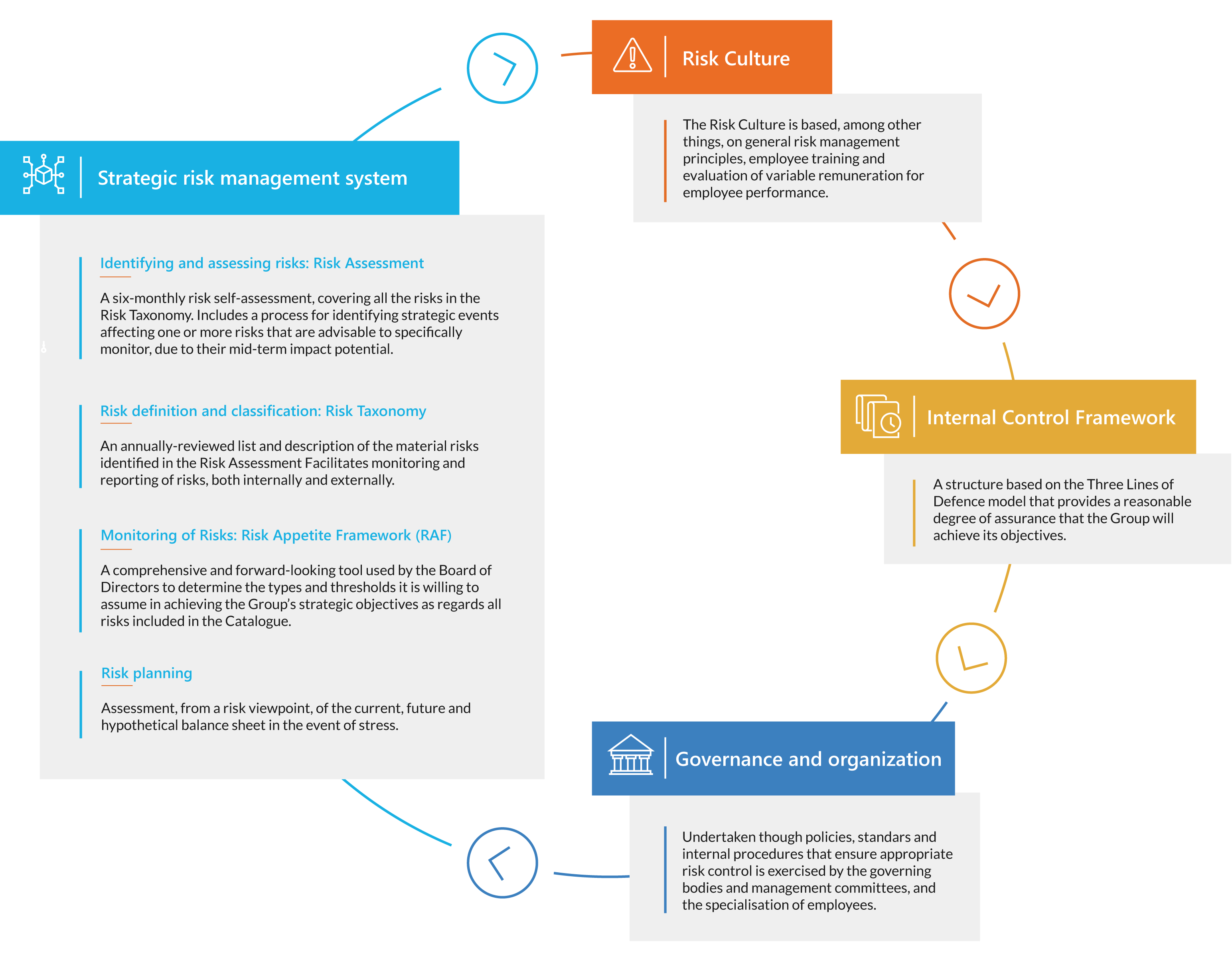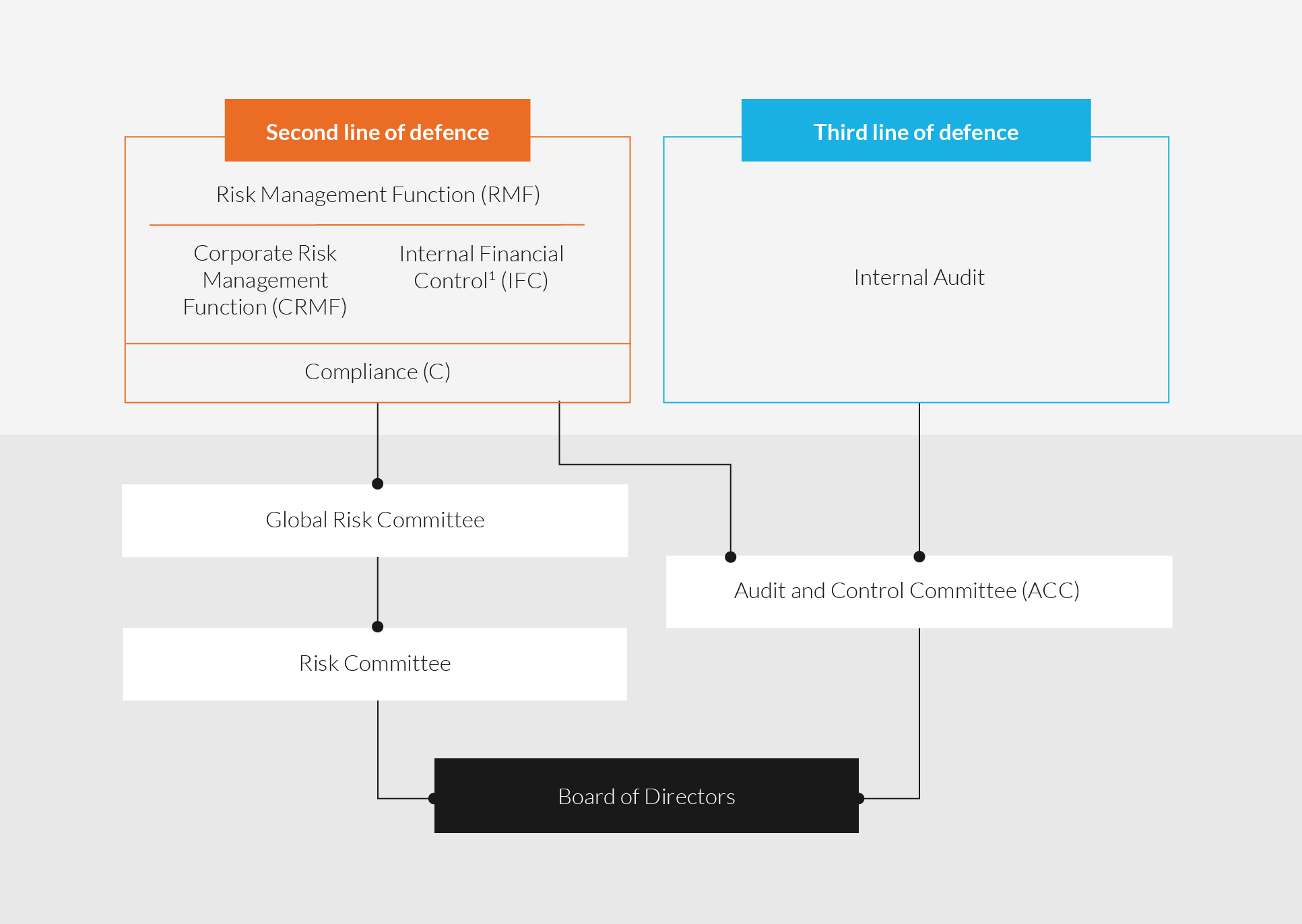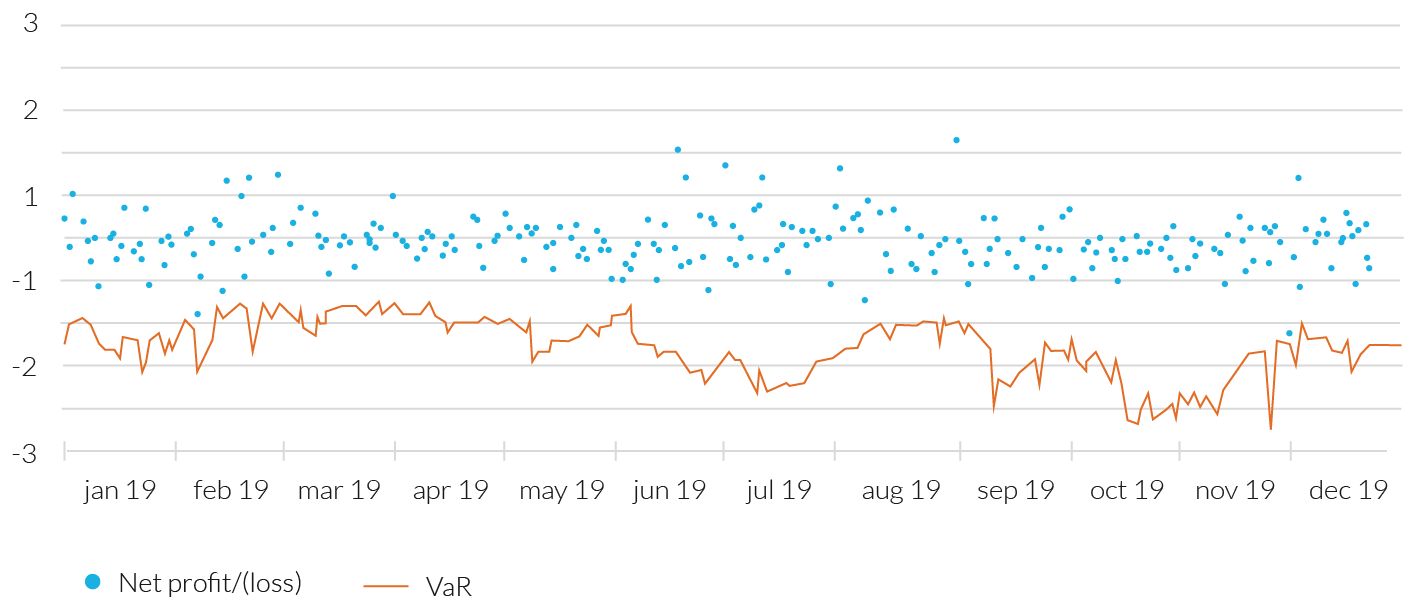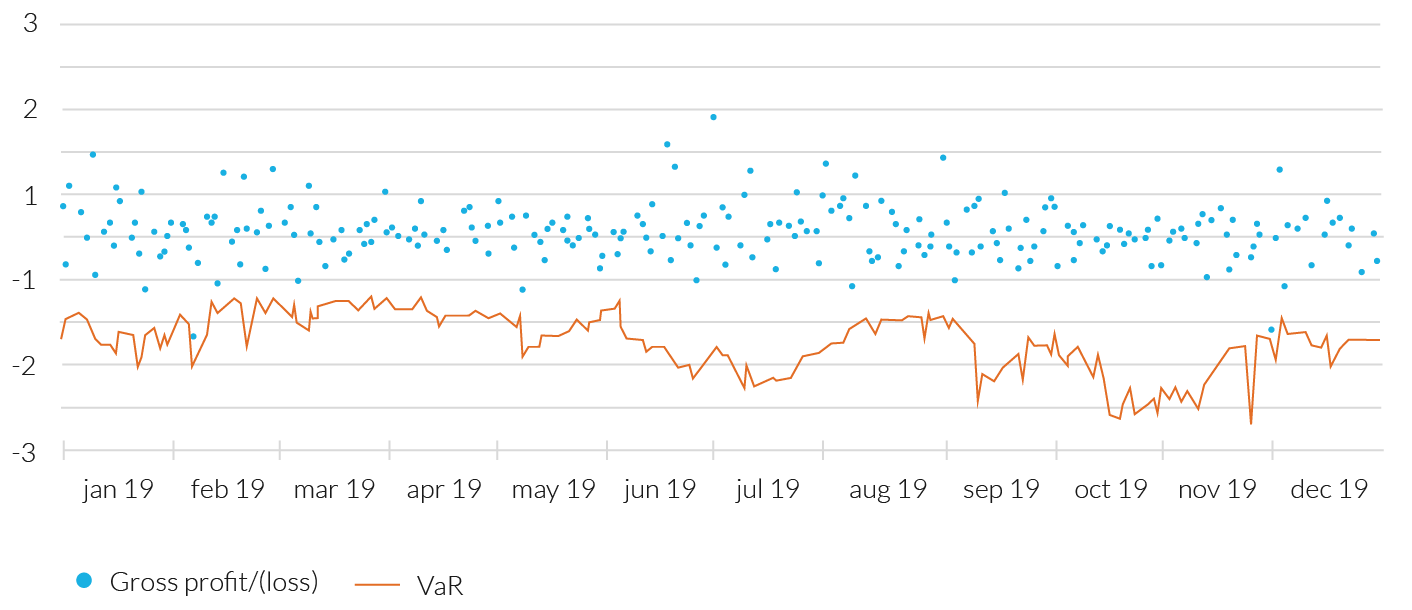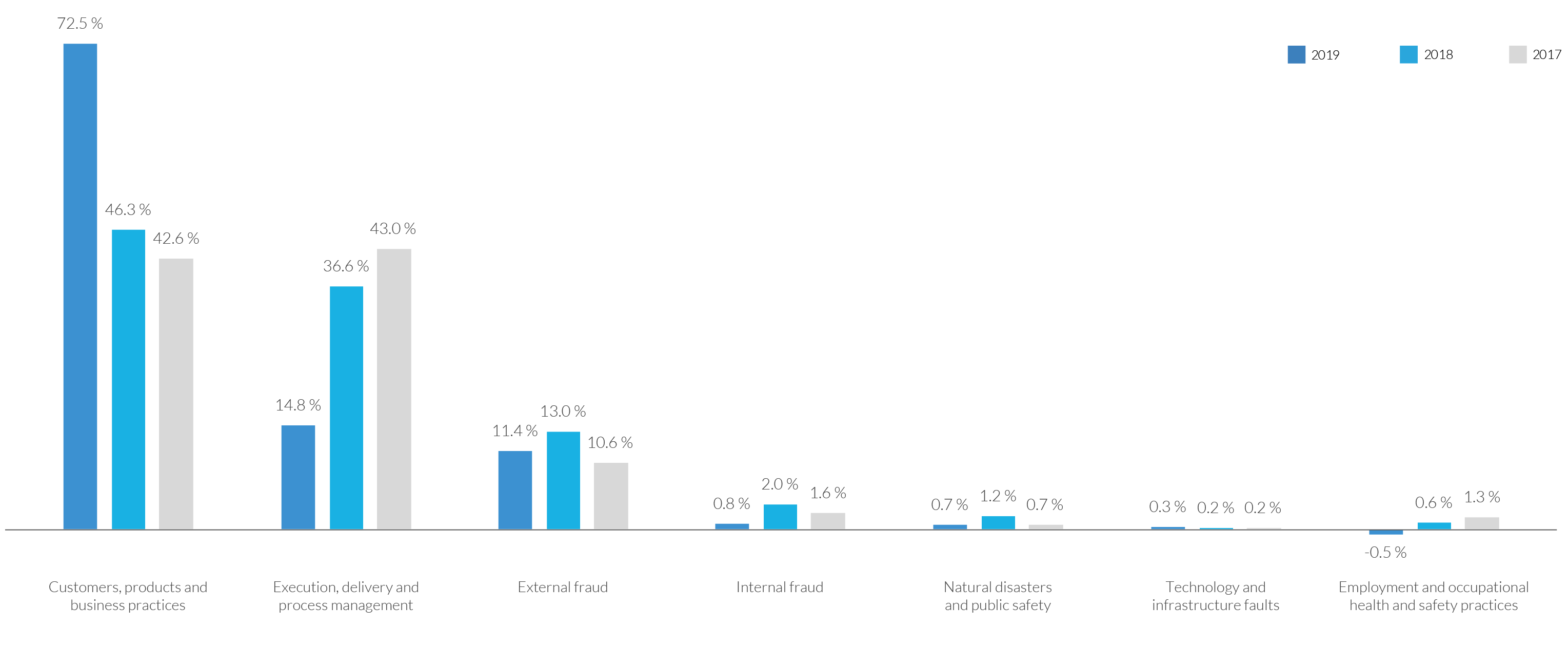1
Macroeconomic environment
Global economy
In 2019, the global economy has faced a considerable surge in uncertainty due to economic and geopolitical factors which, to a great extent, were already in operation in 2018. In terms of the economy, firstly, the doubts cast surrounding the speed and risks entailing the slowdown of the Chinese economy have featured prominently. Up to now, this slowdown has been gradual and the authorities still have mechanisms to temper its intensity. However, there are still concerns regarding the imbalances afflicting Spain. Similarly, the economic downturn experienced by the main developed economies results in a second factor burdening growth. This dynamic comes, on one hand, from the maturity of the economic cycle and, on the other hand, from idiosyncratic factors belonging to each country. Thus, in the US, the gradual fading of the boost from tax measures implemented at the end of 2017 and the start of 2018 is beginning to show in the economy. In the Eurozone, the manufacturing sector, and in particular the automobile sector, continues to undergo complicated circumstances.
The US's protectionist swing, which has remained active throughout 2019, has featured notably on the geopolitical front. Similarly, there has been a slight rise in tensions between the US and the European Union (EU) after the World Trade Organization's ruling in favour of the US with regard to a case of public aid granted to Airbus by the EU, which has enabled the US to impose tariffs on a range of European products. Nonetheless, it is worth stating that at the end of the year a trade agreement between the US and China now looks more likely, although only following a tough and lengthy negotiation phase that is bound to generate uncertainty until an agreement is hammered out.
These risk sources are reflected in the behaviour of the financial markets which, after the strong juncture of volatility experienced at the end of 2018, showed new aversion to risk in the summer, when the stock exchanges of the main developed economies fell due to poor financial data and to the worsening of commercial activity between the US and China. In such a context, and faced with the outlook of a more accommodative monetary policy that is sensitive to risk balance worsening, the interest rates of sovereign bonds fell significantly (to all-time lows in the case of Europe).
Eurozone
The Eurozone's risk context has been marked by geopolitical factors, mainly linked to the difficulties of reaching an agreement for the United Kingdom's withdrawal. These political uncertainties come in addition to the economic downturn that began in 2018, which has been exacerbated in 2019, partly due to the aforementioned plight suffered by the manufacturing sector and the automobile sector, in particular. Thus, after growing 1.9% in 2018, it is estimated that the sector will have only grown 1.1% in 2019 and that it will maintain a similar pace in 2020.
In the face of this context of a downturn in macroeconomic conditions, the main central banks have repositioned their monetary policies. Thus, given that inflationary pressures are relatively contained within the US, and faced with the outlook of an economic downturn, the Federal Reserve cut rates three times throughout 2019 and, furthermore, in order to stall possible cash-flow problems on the market, initiated new bond purchases. The ECB launched a new stimulus package in September 2019, with a 10-bp reduction in the deposit rate (supplemented by a tiering system), new bond purchases (EUR 20 billion a month), lower interest rates for TLTROs (operations offering long-term financing to the financial sector) and it was stated that the stimulus will continue until inflation approaches its target. Although the measures are of a lower magnitude than those of the past, they emphasise that the environment of low rates will be extended for a long period of time.
Spain
In 2019, the Spanish economy's growth rate has maintained the trend it began in 2018, and continues along a slight reduction (although it remains above the Eurozone's average rate of growth). Thus, Spain's economy has grown 2.0% in 2019 and GDP is expected to rise by 1.5% in 2020. The reason for this slowdown is, on one hand, the aforementioned decline in the international outlook, which has effected the performance of external demand, and, on the other hand, lower growth of domestic demand, as a result of the behaviour of consumers who are warier about the macroeconomic outlook. Similarly, public finances have continued to improve: the public deficit stood at 2.5% of GDP in 2018, a drop of half a point in a year, which brought Spain out of its excessive deficit situation, with the forecast further 2-tenth reduction for cyclical effects this year. However, public debt remains at high levels, close to 100% of the GDP. As this is an overview, it is worth stating that the downside risks surrounding the macroeconomic scenario are not insignificant. Those present in the international setting – such as the trade disputes between the US and China, and the UK's withdrawal process from the EU – feature most prominently. In Spain, the formation of a new coalition government after a year dominated by election dates represents a factor of stability.
Portugal
The Portuguese economy has slowed down to a certain extent due to reduced internal demand, in such a way that the growth rate for the whole of 2019 was 1.9%, slightly lower than in 2018 (2.4%). Nonetheless, the overall assessment of the Portuguese financial situation remains positive: the public accounts continue to improve, the job market is prospering, and consumer confidence remains at high levels. The good performance of the economy is reflected in the country's risk premium, which has fallen significantly in 2019. As regards the political arena, the Socialist Party won the elections on 6 October 2019 without reaching an absolute majority. It is expected that economic policy will be a continuation of the previous administration, and thus that public accounts will continue to improve. With this undercurrent, the strong growth rate shown by the real estate market is a source of concern. Although most indicators forecast a gradual moderation, given the importance of non-residents for the sector, the possibility of a sharper correction in the event that the declining international environment generates a risk aversion juncture entailing a withdrawal of foreign investment should not be ruled out.
1Royal Decree 309/2019, of 26 April, which partially enacts Act 5/2019, of 15 March, which governs real estate credit contracts and adopts other financial measures, and Order ECE/482/2019, of 26 April, which amends Order EHA/1718/2010, of 11 June, which governs and controls the advertising of banking services and products, and Order EHA/2899/2011, of 28 October, on the transparency of banking services and customer protection.
2The initials refer to the Capital Requirements Regulation and Directive (CRR/CRD), the Bank Recovery and Resolution Directive (BRRD), and the Single Resolution Mechanism Regulation (SRMR).
2
Regulatory changes
The regulatory outline on which the Group's business model lies is crucial to its development, whether in terms of methodological or management processes. Thus, regulatory analysis represents a key point in the Group's agenda.
The main developments and enquiries open in the field of risks during 2019 are shown below:
On 21 February 2019 the Congress of Deputies approved the Property Credit Contract Regulatory Act (Ley 5/2019 reguladora de los contratos de crédito inmobiliario – LCI), reducing the expenses associated with changes in mortgage contracts and establishing measures to improve transparency in the conditions. Thus, the process of transposing the Directive 2014/17/EU of the European Parliament and of the Council closed of 4 February 2014. Similarly, on 26 April the Ministry of Economy and Business completed the CLI with the approval of a Royal Decree and a Ministerial Order1 developing aspects as the transparency of information; calculating the financial loss and reference indexes and rates to apply; the training and skills requirements of commercial staff; and the criteria applicable to related marketing.
CaixaBank – in due time and in a suitable manner – has fulfilled the appropriate measures, carrying out necessary adjustments to internal procedures and standards, and suitably training personnel in order to ensure the correct marketing of the products affected under the standard (see section 3.2.3. Risk Culture). .
Approval and publication in the Official Journal of the European Union (OJ) of the “Proposal of CRDV Package”: once the trilogue was completed during first few months of the year, the review started in November 2016 by the European Commission of the “banking package” that covers the texts CRD V, CRR II, BRRD II and SRMR II was approved on 16 April in the plenary session of the European Parliament2. The review basically transposes the standards agreed by the Basel Committee on Banking Supervision (prior to the 2017 agreement on the completion of Basel III, the adaptation of which has begun to be addressed as of the second half of 2019). This legislative package entered into force on 27 June 2019, with December 2020 as the deadline for Spain to transpose the directives, whilst the majority of changes included in the CRR II are applicable from June 2021 (December 2020 in the case of the SRMR II).
Brexit, Contingency Action Plan : the Agreement on the Withdrawal of the United Kingdom from the European Union, of 24 January 2020, entered into force on 1 February 2020. The treaty established a transition period until 31 December 2020, during which EU legislation will still be applied in the United Kingdom and allowing activities to continue with this country as they have until now. Furthermore, the European Banking Association (EBA), the Prudential Regulation Authority (PRA) and the Financial Conduct Authority (FCA) have agreed to a memorandum of understanding (MoU) establishing the bases in terms of cooperation and exchange of information between EU authorities and the United Kingdom.
In the context of the Action Plan to reduce NPLs by the European Council, on 19 June the EBA launched the consultation process on its draft Guidelines on loan origination and monitoring regarding the granting, monitoring and internal governance of loans, focusing on aspects such as transparency and borrower affordability assessment. The main goal of the guidelines, which is, in principle, due to come into force in June 2020, is to ensure that institutions have robust and prudent standards for credit risk taking, management and monitoring, and that newly originated loans are of high credit quality, ensuring the possibility of loans becoming non-performing in the future is reduced, while respecting consumers' rights.
In the interest of maintaining the best standards of the market and consumer protection, CaixaBank has played a special role in analysing the implications of the guidelines subject to consultation and anticipation of the final provision of the standard.
On 22 August the ECB published a statement in which it updated its supervisory forecast regarding prudential provisions due to the new non-performing exposures (NPEs). The supervisor has adapted its Pillar 2 expectations for certain exposures converted into NPEs starting from 1 April 2018, aligning them on the calendar with the Pillar 1 requirement recently added to the CRR as regards minimum coverage for these NPEs (known as the prudential backstop).
The Group, aligned with the aim of reducing the current and future accumulation of doubtful positions, has carried out various initiatives, such as the sale of non-productive assets, as well as activities with the aim of improving the early NPL admission and management processes in order to reduce entries and adapt RAF metrics to ensure a comfortable compliance with regulatory requirements.
EBA response, on 5 August and 4 December, to the European Commission's Call of Advice on the assessment of the implementation of the finalisation of Basel III reforms by the Basel Committee on Banking Supervision. Both reports set out policy recommendations: in the fields of credit risk, operational and output floor in the first, and the Fundamental Review of the Trading Book (FRTB), the credit valuation adjustment (CVA) risk framework and an assessment of the macroeconomic impact, in the second. They notably feature, for example, the EBA's negative stance vis-a-vis the maintenance of European specifics as the factor for supporting SMEs in credit risk, and CVA scope exclusions in the field of counterparty credit risk; they are in favour of the implementation –without alterations– of the Basel Committee's proposal.
On 10 October the European Commission began the reference period, the result of which – together with the EBA's response to the Call of Advice – will be considered in the process of transposition to European standards.
CaixaBank maintains an active role, both internally and externally, in the debate on the standard, carrying out successive exercises on assessment and contrasting of reasonableness in congruence with the implications and demands of other regulatory deployments.
3
Strategic events
Strategic Events are the most relevant adverse occurrences that may represent a medium-term threat to the CaixaBank Group. Only events that the entity is exposed to due to causes that are external to its strategy are considered, even if the severity of their impact can be mitigated through management.
In order to be able to anticipate and manage their effects, in this sense, the following most relevant strategic events identified in this financial year are listed below:
Uncertainties in relation to the geopolitical and macroeconomic environment
Economic perspectives point to a gentle deceleration of economic growth in forthcoming years in Spain, but the loss of trust or the emergence or aggravation of geopolitical events could cause a stronger slowdown than expected. Among other effects, this scenario would lead to diminished demand for loans and advances and the deterioration of credit quality.
Mitigating factors: an event of this nature could have a relevant financial impact. In this regard, the Group understands that such risks are sufficiently managed by its levels of capital and liquidity, validated by compliance with both external and internal stress exercises, and reported in the annual internal capital and liquidity adequacy assessment processes.
Persistence of an environment of low interest rates
Although market expectations suggest the very gradual recovery of interest rates in the years to come, we cannot rule out the possibility that the current environment of ultra-low rates may go on for longer than expected, and that they may even decrease further.
Mitigating factors: the effects of an environment of persistently low interest rates could result in the materialisation of the structural interest rate risk and the business risk. The Group manages and controls both risks by continually monitoring compliance with the budget, measuring the impact on the economic value of the balance sheet and on the financial margin, according to generally accepted methodologies within the industry, and through the permanent analysis of the offer of new products and services that are betters suited to this environment from a perspective of balancing returns and risk.
New competitors with the possibility to disrupt
There is an expectation that the competence of newcomers will increase, such as Fintechs, Agile Banks, Global Asset Managers and Bigtechs with the potential to disrupt in terms of competence or services. This could lead to the disaggregation and disintermediation of the chain of value, which in turn would lead to an impact on margins and crossed sales, given that we would be competing with more agile, flexible companies with very light cost structures. All of this could be worsened if the regulatory requirements applicable to these new competitors were not the same as those in place for current credit institutions.
Mitigating factors: the Group considers new entrants a threat, whilst also seeing an opportunity for collaboration, learning and stimulus to meet the objectives of digitalisation and business transformation established in the Strategic Plan. The Group periodically monitors the main newcomers and the BigTech movements within the industry. The Group also has Imagin as a first-rate value proposal that it will continue to leverage. With respect to the competition from Bigtechs, the Group is committed to improving the customer experience with the added value resulting from its social sensitivity (bits and trust), whilst suggesting potential collaboration approaches (open banking).
Cybersecurity
The volume and severity of cybersecurity events increased in 2019. In parallel, regulators and supervisors have escalated the priority of this field.
Mitigating factors: the Group is also well aware of the importance and extent of the existing threat, and thus is constantly reviews the technological environment and applications: in its aspects of integrity and confidentiality of information, as well as the availability of systems and business continuity, both with planned reviews and continuous auditing by monitoring the defined risk indicators. Furthermore, the Group is conducting the analyses needed to adapt its security protocols to new challenges, and has defined a new strategic plan for information security, so that it can remain on the cutting edge of information protection in accordance with the best market standards.
Risks related to climate change
Conceptually, the risks associated with climate change are classified as physical risks and transitional risks. The former emerge as a result of climatic and geological events and changes in the balance of ecosystems, and can be gradual or abrupt. They can entail physical damage to assets (infrastructures, properties), disruptions in production or supply and/or changes in the productivity of economic activities (agriculture, energy production). Meanwhile, transitional risks are associated with the fight against climate change and the transition towards a low-carbon economy. They include factors such as regulatory changes, the development of alternative energy-efficient technologies, changes in market preferences or reputational factors associated to activities with a high impact.
Mitigating factors: CaixaBank actively manages environmental risks and those associated to climate through the different lines of activity of its Road Map, including:
- Implementing an Environmental Risk Management Policy.
- Defining and deploying environmental and climate change governance to supervise fulfilment of the Group's objectives.
- Risk Metrics, ensuring that they comply with the risk appetite defined, applicable regulations and stakeholder expectations.
- External Reporting in accordance with applicable regulations and best practices.
- Communication that effectively and transparently provides the information required by stakeholders on this matter.
- Taxonomy: structure and categorise customers, products and services from an environmental and climate change perspective, in accordance with global standards and regulatory requirements currently being developed.
- Business opportunities: ensure that CaixaBank capitalises on current and future business opportunities relating to sustainable funding/investment under the framework of the Environmental Strategy, including the issuance of sustainable and/or green bonds.

